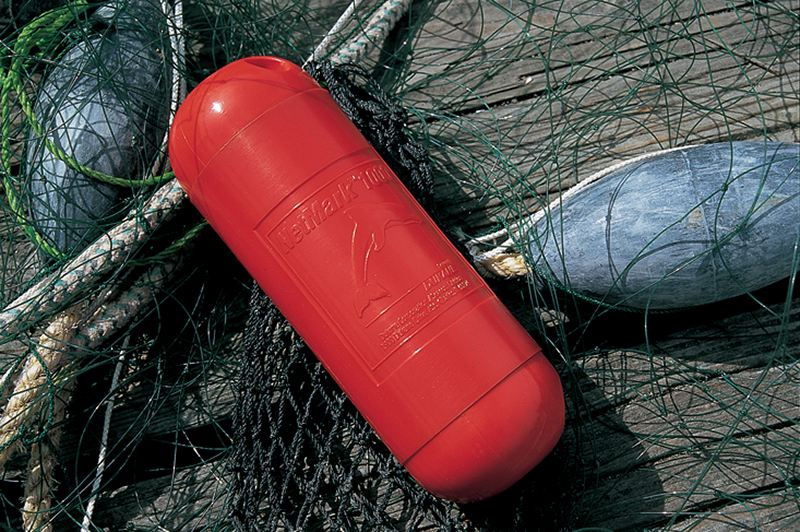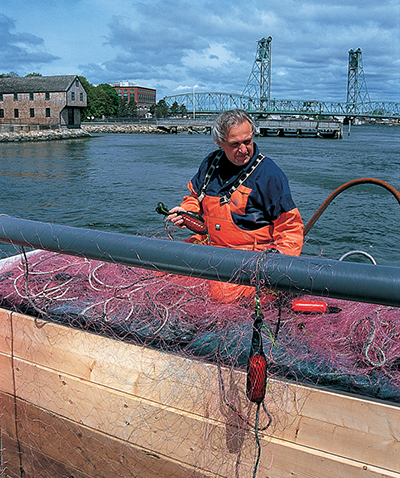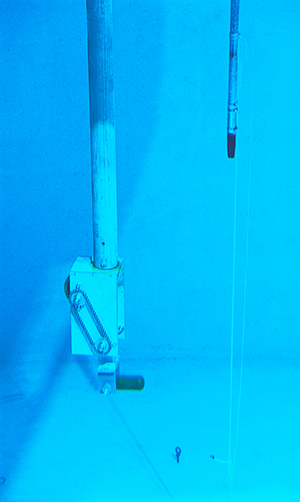
Safeguarding Porpoises
To help protect and preserve the harbor porpoise, a low-cost, easy-to-use acoustical pinger stands to gain wide acceptance in the fishing
industry. For decades, harbor porpoises have been killed in fisheries, such as those located in the Gulf of Maine. Each year, porpoises have fallen victim to sink gill nets, static fishing devices by commercial fisheries that are meant to catch bottom-dwelling fish in near-shore waters.
Taking on the challenge of lessening the incidental catch of harbor porpoises, the Dukane Corporation's Seacom Division, based in St. Charles, Illinois has designed the NetMark™ 1000.
The NetMark 1000 employs technology originally developed in the late 1960s by NASA engineers at the Langley Research Center. At that time, an underwater location aid was crafted, able to withstand high impact, then emit multidirectional signals for hours on end. Its key purpose was for use in the retrieval of NASA payloads following watery touchdowns on Earth.
Dukane Corporation and Burnett Electronics of San Diego, California later obtained a license from NASA, further improving on the beacon design. Dukane has sold well over 100,000 units since.
A variety of applications for Dukane pingers have included: attachment to "black box" flight recorders on commercial airliners, marking underwater sites and relics and helping to ensure recovery of hazardous cargo in case of accidental loss.
Thanks to a team from Dukane, an underwater acoustic pinger is finding new duty in safeguarding the harbor porpoise. At stake was finding a balance between regulatory rulings, including the Marine Mammal Protection Act, as well as the livelihood of a New England fishing community.
A large-scale field experiment off the coast of New Hampshire in autumn 1994 gauged the effectiveness of acoustic pingers in reducing incidental mortality of harbor porpoises in sink gill nets. The study was carried out by the New England Aquarium, along with researchers from Woods Hole Oceanographic Institution, the New Hampshire Commercial Fishermens Association and the University of New Hampshire's Department of Ocean Engineering.
Dukane provided the specially equipped acoustic alarms for the two-month-long experiment. Broadcasting a signal well within the hearing range of harbor porpoises, the pingers provided warning as to position of the sink gill nets, alerting the mammals to help them avoid net entanglement.
The study found that the use of acoustic alarms appears to hold considerable promise in reducing the number of harbor porpoises killed in sink gill nets in the Gulf of Maine. Indeed, a "dramatic" reduction in the entanglement rate of harbor porpoises in the area was reported.
Following the promising results, Dukane has put in place a manufacturing program to produce the low-cost NetMark 1000 pinger. The sausage-shaped hardware—measuring 6.5 inches in length and 2.3 inches in diameter—has been fabricated to take the beating of deck handling and deployment. Capable of projecting a signal every four seconds over a 100-meter radius, the NetMark 1000 operates down to 100 fathoms, powered by four replaceable standard AA Alkaline batteries. Upwards of 35 days of continuous use can be reached before battery change.
In January of 1997, the NetMark 1000 was selected by the editors of National Fisherman for the magazine's "Best of Technology/1996" list, which highlights a collection of the best new gear presented to the fleets during the previous 12 months. Dukane views the NetMark 1000 pinger as the potential standard for an effective, inexpensive acoustic device for reducing porpoise bycatch. Applications of the pinger are not only expanding internationally but to other animal species as well.
NetMark is a trademark of the Dukane Corporation.

John Williamson, manager and regulator for the New England Fisheries Council, attaches the NetMark 1000 to a net in preparation for an in situ test. NASA technology is helping the Council find a balance between regulatory rulings and the livelihood of the local fishing community.

During a test at the University of New Hampshire Ocean Engineering Laboratory, the pinger is dropped to 10 feet below the surface of the water. Scientists then measure the sound pressure waves and frequencies at varying distances.

Originally developed by NASA engineers as an underwater location aid, the fishing industry uses pinger technology to safeguard porpoises from net entanglement. Dukane Corporation's NetMark 1000 emits signals that warn the mammals of the net's presence.













